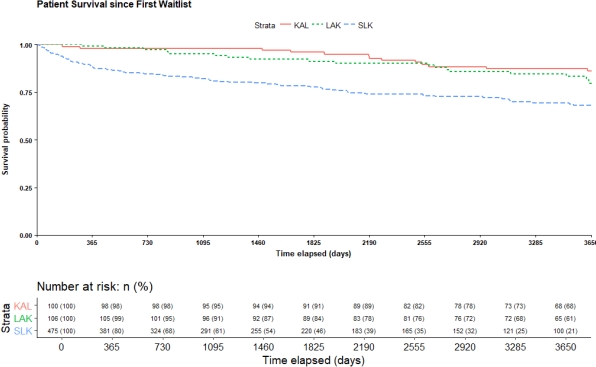First-Time Simultaneous vs. Sequential Liver-Kidney Transplantation in Polycystic Kidney Disease: A Review of the UNOS Database
1Baylor College of Medicine, Houston, TX
2Texas Children's Hospital, Houston, TX.
Meeting: 2018 American Transplant Congress
Abstract number: C221
Keywords: Kidney/liver transplantation, Polycystic kidney disease, Survival, Waiting lists
Session Information
Session Name: Poster Session C: Liver: Recipient Selection
Session Type: Poster Session
Date: Monday, June 4, 2018
Session Time: 6:00pm-7:00pm
 Presentation Time: 6:00pm-7:00pm
Presentation Time: 6:00pm-7:00pm
Location: Hall 4EF
Introduction. Polycystic disease (PKD) may necessitate the need for liver and/or kidney transplantation. The long-term outcomes of simultaneous liver-kidney transplantation (SLK) and kidney-after-liver (KAL) or liver-after-kidney (LAK) have not been well-studied in this patient population.
Methods. The UNOS database was queried for all first-time liver and kidney listings for PKD between 1988- 2016, multivisceral excluded, strata defined at listing (>30 d apart) and transplant (>1d). Patient survival was calculated since time of original listing. Graft survival was calculated since second transplant. Kaplan-Meier analysis compared survival, with log-rank for significance.
Results. The study included 475 SLK, 100 KAL, and 106 LAK listed, of which 286 SLK, 33 KAL, and 38 LAK were transplanted. SLK were older (45 yo) compared to their KAL (41 yo) or LAK (40 yo). More LAK patients were female (50.9%) at initial listing, and least LAK were in ICU at transplant (0 vs 2 KAL and 21 SLK). There was no significant difference in height, weight, or race between the groups. The median wait time and time between transplants (days) for KAL (434/2257), LAK (378/2675) and SLK (470/0) was not significant. The most common reported cause of death on waitlist was multi-organ dysfunction (SLK 73%, KAL 87%, LAK 55%) and infection post-transplant (SLK 33%, KAL 29%, LAK 27%), both not statistically different. In intent to treat analysis, KAL experienced the highest 10-year survival (86%) compared to LAK (79%) or SLK(68%) (p<0.05) (Figure 1). However, the 10-yr survival of the three strata were comparable at 10-yrs when patient survival was calculated from time of first transplant (SLK 81%, KAL 84%, LAK 82%), with no significant difference in liver or kidney graft survivals.
Conclusion. The best patient survival was in the group listed for liver transplantation first, possibly due to reduced cholangiitis and portal hypertension while renal disease could be medically managed. These results suggest that it may be better to list patients according to their medical condition and current transplant needs.
CITATION INFORMATION: Nguyen P., Rana A., Miloh T. First-Time Simultaneous vs. Sequential Liver-Kidney Transplantation in Polycystic Kidney Disease: A Review of the UNOS Database Am J Transplant. 2017;17 (suppl 3).
To cite this abstract in AMA style:
Nguyen P, Rana A, Miloh T. First-Time Simultaneous vs. Sequential Liver-Kidney Transplantation in Polycystic Kidney Disease: A Review of the UNOS Database [abstract]. https://atcmeetingabstracts.com/abstract/first-time-simultaneous-vs-sequential-liver-kidney-transplantation-in-polycystic-kidney-disease-a-review-of-the-unos-database/. Accessed December 29, 2025.« Back to 2018 American Transplant Congress

